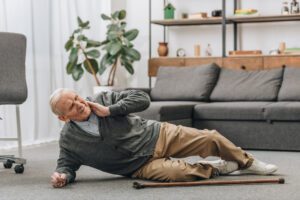What to Check After an Aging Person Falls

Falls by an older person shouldn’t be taken lightly. Even if no injuries are apparent, and it seems the individual tripped and fell, it’s still important to be proactive about getting the proper medical assessment after a fall.
Most doctors’ visits after a fall are to check resulting injuries, but more care is warranted. Falls (even minor ones) can be warning signs of underlying new, possibly serious medical problems that need treatment to prevent future falls and/or injuries.
Below are eight things that should be included in a thorough work-up by a doctor after a fall:
- Doctors should assess for underlying new illnesses. If an aging person has been feeling unwell or experiencing weakness or delirium, these symptoms could be a clue of where to start looking. Possible health problems include dehydration, urinary tract infections, anemia, pneumonia, heart problems, or strokes.
- Take a blood pressure and pulse reading when sitting and when standing. This is an especially useful test if your loved one has been lightheaded or feeling faint. If s/he takes blood pressure medication, the doctor should confirm that s/he isn’t experiencing a drop in blood pressure when standing up.
- Check blood tests. A complete blood cell count (CBC) and a metabolic panel are great places to start. Falls can worsen if a blood count is off or blood sodium gets too high or low. If the individual has diabetes and takes insulin to lower blood sugar, bring a glucometer or a blood sugar log. Episodes of low blood sugar (hypoglycemia) are an important risk factor for falls.
- Review medications. Many medications taken by older adults can increase fall risk. In many cases, these medications can be reduced or even eliminated. Doctors should especially address the following medications: sedatives, tranquilizers, sleeping medications, blood pressure and diabetes medications, opiate pain medications, and anticholinergic medications (often given for allergies, overactive bladder, vertigo, nausea, and nerve pain).
- Check gait and balance. The doctor should carefully watch the way the older person is walking. Suppose discomfort seems to be the source of problems (such as pain in feet, joints, or back). In that case, the doctor can either address it or give a referral to a physical therapist, who could recommend suitable strengthening exercises.
- Check Vitamin D level. Treating low Vitamin D levels can help reduce falls in older adults and the risk of fragile bones. Treatment is generally simply getting outside more or taking supplements.
- Evaluate underlying heart or neurological conditions. A chronic problem with the heart or blood pressure system or a chronic neurological issue, such as Parkinson’s disease, could lead to falls. It’s particularly useful to look into this possibility if falls repeatedly happen, especially if caretakers have already minimized risky medications and monitored blood pressure.
- Get a vision, podiatry, and home safety referrals. Your loved one may be falling because his or her eyes are failing or she needs podiatry care. Home safety evaluations can be very helpful in preventing future falls.
Since a caregiver typically knows the senior better than the doctor, it’s important to be politely proactive about asking questions to ensure important things aren’t overlooked, such as mentioning medications that could affect balance or other potentially dangerous issues.
Unfortunately, sometimes the elderly are not found right away after a fall, particularly if they live alone. For peace of mind and to guarantee the best outcome after a fall, loved ones may want to consider implementing the Gardeen monitoring system. Gardeen is a lightweight bracelet worn by the monitored individual, with a sensor that captures and delivers data showing activity changes over time.
This non-invasive, technology-driven product provides aggregate data shared with users, caregivers, and family members through the easy-to-use smartphone app and dashboard. Gardeen provides a complete client event history by analyzing all sensor data to flag critical changes, such as fall detection, bracelet not worn, nighttime wandering, user inactive, excessive time spent in the bedroom, excessive inactive time, and a change in sleep patterns.
The beauty of Gardeen is that the individual retains privacy and dignity. At the same time, the product provides an unobtrusive window into what was once his or her unobserved day-to-day activities. The tracked trends can demonstrate either that the participant is thriving and safe in his or her environment or that consideration for additional care and/or safety measures may be needed. For more information about Gardeen, visit https://gardeenllc.com.
Additionally, caregivers or loved ones should ensure that the elderly person’s home is laid out in a way that helps prevent falls. For example, the floor plan in each room should leave lots of open spaces around which the individual can maneuver. Installing grab bars and handrails around the house can also be a good idea. Remove any tripping hazards, such as clutter on the floor. Flooring should be non-slip, and lighting should be optimal.
